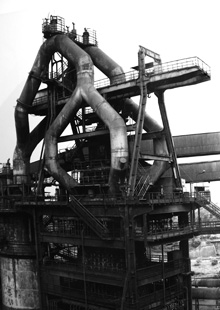- Steel Rigid Frame Manual: Design and Construction
My steel research began by looking at welding diagrams and gigantic rigid steel frames. I looked up every steel manual in the Architecture library. Although interesting, and certainly worthwhile, I-beam specifications and steel pipe thicknesses were not going to be enough to fully introduce me to the possibilities of steel construction.
My first interesting find was some information on two of the most basic ways of joining steel components; riveting and welding. Although riveting possesses a rigid aesthetic and creates powerful forms with thick plates and massive nuts and bolts, the bottom line turns out to be that it is in most cases just not practical. Not only does welding cut down on the amount of steel necessary to build, but construction is quicker and far less limited. Welded steel joints share every advantage that rivet construction does plus much more.

For example, the riveted plates in the above image stand out in an almost overwhelming sense. However, if you look closely you will notice the weld symbol and the barely noticeable seam between the two plates. Welded joints, if done correctly, can go almost unnoticed.
It was not until I began looking at more contemporary steel structures that I noticed how endless the possibilities of steel construction could be, and how fast the use of steel in building has advanced. First, take a look to the detail below at Crown Hall, Mies' architecture building on the IIT campus finished in 1956. Mies uses welded plate girders to span the entire width of the roof.

Less than 50 years later, Renzo Piano is using steel trusses to span the entire width of an airport, as well as creating flowing forms from tubular steel.
The innovation does not stop here either. Along with Renzo Piano, Richard Rogers and Frank Gehry are using steel to create spectacular details and outrageous forms, unimaginable just 50 years ago. The framework in Gehry's Walt Disney Concert Hall is almost entirely made from steel. The image below shows the structure before being clad in its titanium finish.

Lastly, take a look to a detail done by Richard Rogers that I feel utilized the potential of steel to quite an extent. The below detail uses welds, rivets, tension cables, steel piping, plate steel, and pin connections that allow for movement all in one structural element.

In conclusion, it seems that steel is a material that lends itself to innovative use. With today's technology steel fabrication is endless, from the smallest details and joints to trusses that span the length of a building. My imagination before flipping through a stack of books stopped around prefabricated steel components, but has ended in a world where steel can be welded at any angle and bent or cut into almost any shape. I think one of the most promising aspects of the semester ahead of us is the opportunity to work with no limits and create a building with "custom" steel structure and details.


No comments:
Post a Comment